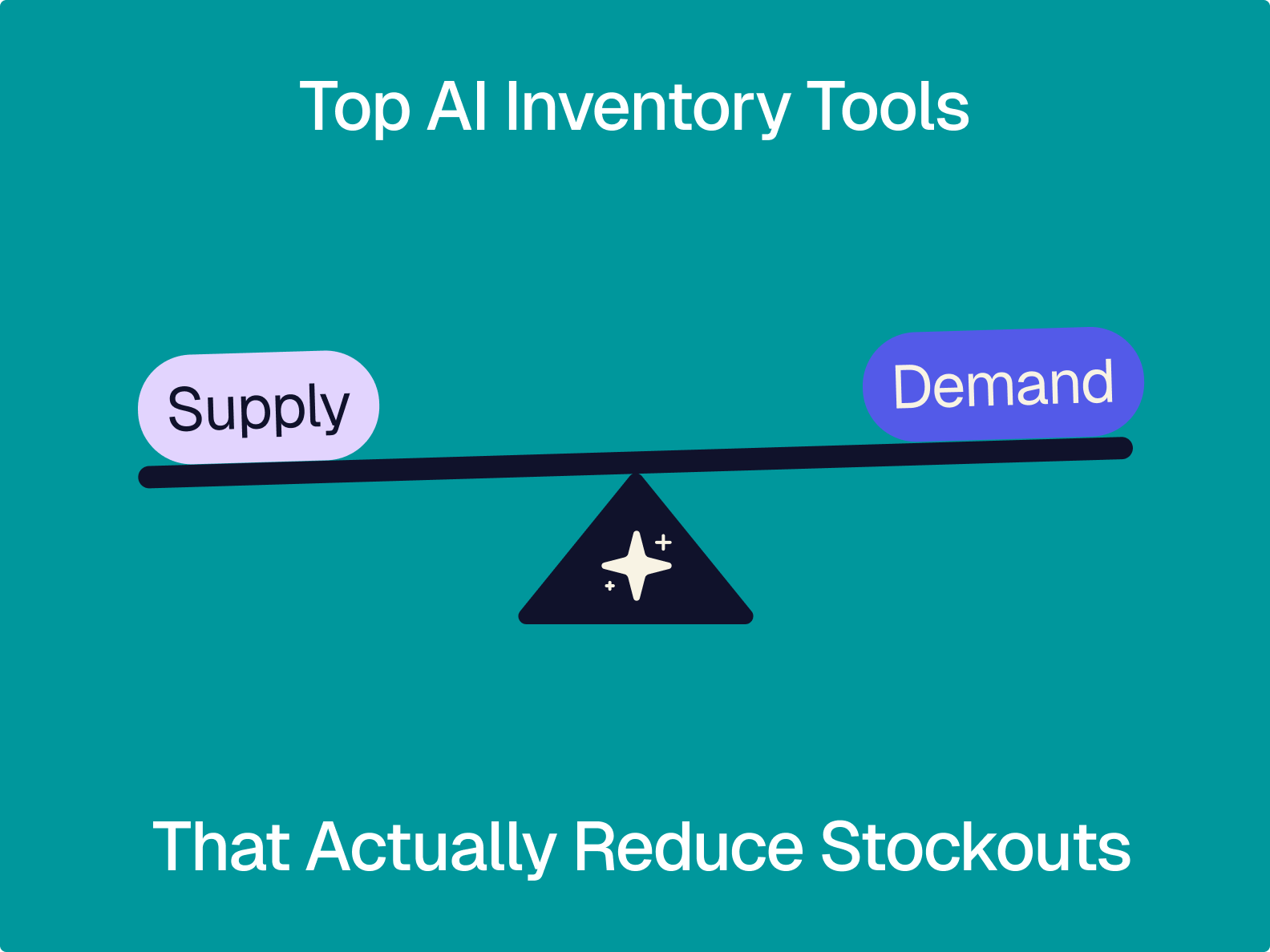Spreadsheets and legacy inventory management platforms weren’t designed for today’s retail complexity. And when a customer clicks “add to cart” expecting to have the product at their door in a few days, but gets an out-of-stock notification instead, your outdated system is losing you both sales and trust.
The best AI inventory management tools help your team prevent stockouts and deliver a seamless omnichannel experience.
Features like demand forecasting, automated replenishment, and intelligent data validation simplify the process of keeping exactly the right amount of stock available at all times..
In this blog post, you’ll learn about five of the best AI tools for inventory management that help reduce or prevent stockouts for retail brands.
What You’ll Learn
- 5 Best AI Inventory Management Software
- How to Choose the Right AI Management Software
- Future Trends in AI Inventory Management
5 Best AI Inventory Management Software
| Tool |
Who It’s Best For |
How It Helps Reduce Stockouts |
Key Features |
Pros |
Cons |
| Tailor |
Mid-market retailers who are scaling up |
Order recommendations, data validation, headless architecture to integrate with demand forecasting tools |
AI-driven OCR, AI-enhanced forecasting and demand planning, intelligent data validation and conversion |
Customizable API-first architecture; unlimited two-way integrations; real-time cost accounting; great for retailers with multi-channel sales and distribution; built for headless commerce |
Not ideal for small businesses; may require learning curve for teams used to legacy systems |
| Verusen |
Larger enterprises with existing ERP infrastructure (manufacturing, industrial, transportation industries) |
AI features like decision logic, risk forecasting, data classification |
Explainability AI agent, duplicate material identification, criticality-based inventory optimization |
Strong ERP integrations; proactive risk detection; large-scale visibility; cleans up raw data |
Not great for SMBs; pricing not listed upfront; may have a steeper learning curve |
| RELEX |
Mid-sized retail, wholesale and distribution, and CPG manufacturing companies |
Automatically generating orders when needed using cross-functional planning and the RELEX Mobile forecasting tool |
Automatic replenishment, supply chain visibility, phantom inventory alerts |
Works well across multiple systems; automatic replenishment; easily handles large inventories; scales up right along with you |
Time-consuming to implement; likely out of budget for smaller teams |
| ToolsGroup |
Mid-sized to enterprise-level retailers, distributors, or omnichannel businesses |
Probabilistic demand forecasting to help accurately plan inventory |
Probabilistic forecasting, demand sensing, scenario planning |
Easily handles complex supply chains; visibility into AI decisions; flexible modeling; self-learning forecasts; support for omnichannel inventory planning |
Interface isn’t as intuitive; needs clean data for best results; overly complex for smaller teams |
| EazyStock |
Small- to mid-sized distributor, wholesaler, or ecommerce business |
AI-powered demand forecasts, automatic replenishment recommendations, and risk of stockout KPIs |
Forecasting and seasonal demand, redistribution suggestions, automated replenishment proposals |
Quick to implement; interface is easy to navigate; cloud-based with automatic updates; high ROI for SMBs; automatic demand classification; good for businesses with multiple locations |
Not designed for large enterprises; advanced customization is limited; focuses mostly on inventory, not full supply chain |
1. Tailor: Prevent Stockouts with Real-Time, AI-Driven Inventory Data
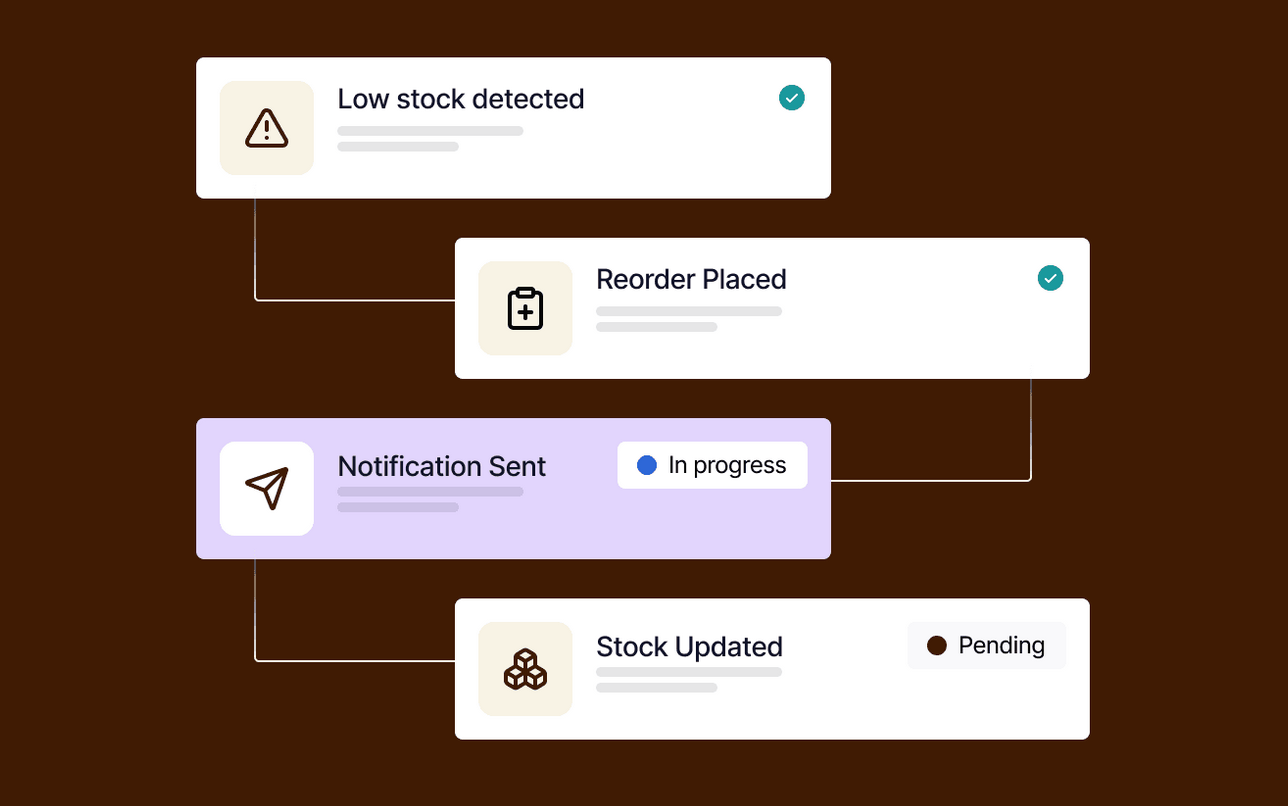
What it is: Tailor is a composable ERP with AI-powered inventory management features, built to help retailers reduce stockouts and improve operational accuracy. It’s the perfect size for mid-market brands who are scaling up from the spreadsheet stage — and the AI is trained specifically on retail context, providing extra accuracy for retailers.
How it helps reduce stockouts: Tailor prevents stockouts by using a combination of automated order recommendations and intelligent data validation. Tailor’s flexible, headless architecture makes it easy to couple up with other tools to enable demand forecasting. While Tailor doesn’t currently make recommendations or handle demand planning itself, our composable infrastructure simplifies the process of plugging into other predictive inventory platforms.
Key AI-Powered Features
- AI-driven OCR. Takes structured data from unstructured sources, converting documents into data that’s ready for ERP workflows with minimal human input.
- Flexible, headless architecture. Composable infrastructure makes it simple to integrate with demand forecasting tools.
- Intelligent data validation and conversion. Ensures all incoming data matches up with ERP requirements, helping you save time and scale up with accuracy.
What Else to Know
Tailor is flexible and customizable. It fits into your current ERP and has low-code integrations that are quick to get up and running.
Pros and Cons
Pros:
- Customizable API-first architecture
- Unlimited two-way integrations with retail tools
- Real-time cost accounting
- Great for retailers with multi-channel sales and distribution
- Built for headless commerce
Cons:
- Not ideal for small businesses
- May require learning curve for teams used to legacy systems
How to Get Started
Learn more about how our inventory management software works. Or request a demo and our sales team will walk you through the product.
2. Verusen: Eliminate Inventory Blind Spots with Unified Data Intelligence
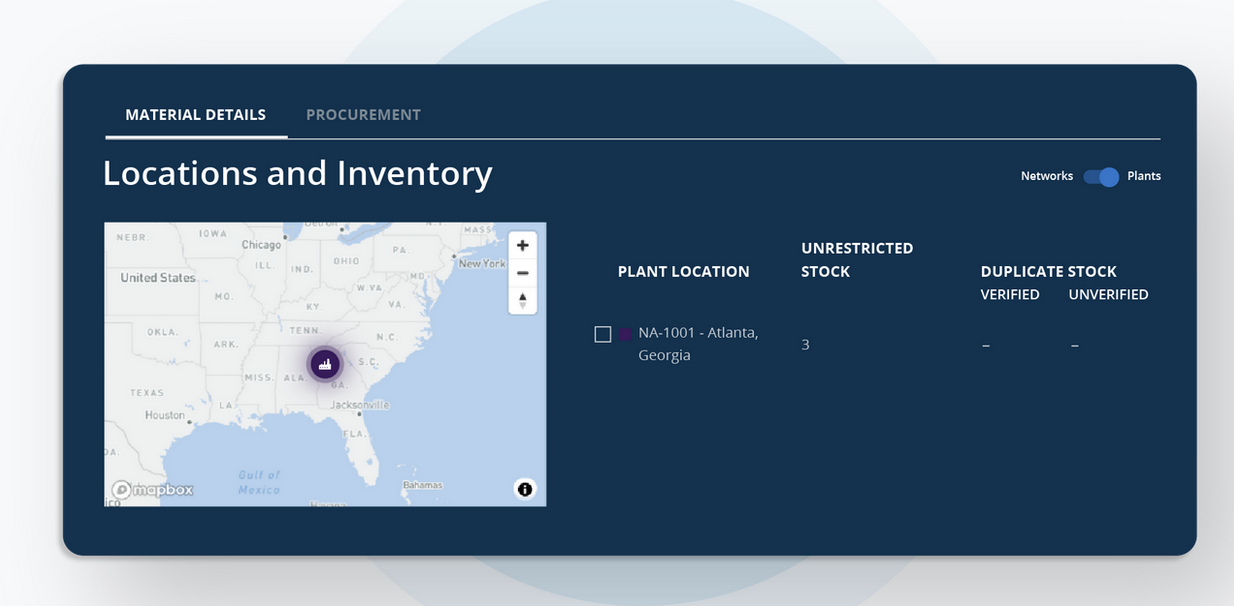
What it is: As an MRO inventory software, Verusen uses AI to clean inventory data for companies that provide critical supplies in industries like manufacturing, industrial, and transportation.
How it helps reduce stockouts: AI features like decision logic, risk forecasting, and data classification combine to help prevent stockouts.
Key AI-Powered Features
- Explainability AI agent. Explains to users the “why” behind each AI recommendation.
- Duplicate material identification. Automatically identifies and consolidates duplicate data, reducing errors in inventory counts and purchasing.
- Criticality-based inventory optimization. Assigns criticality scores to spare parts to optimize stocking policies.
What Else to Know
Verusen is best for large enterprises with existing ERP infrastructure. If you’re on the smaller side, this AI inventory management software may not be the best fit — it’s designed for companies already handling a high complexity of data.
Verusen Pros and Cons
Pros:
- Strong ERP integrations
- Proactive risk detection
- Large-scale visibility
- Cleans up raw data
Cons:
- Not great for SMBs
- Pricing not listed upfront
- May have a steeper learning curve
3. RELEX: Maximize Shelf Availability with AI-Powered Replenishment
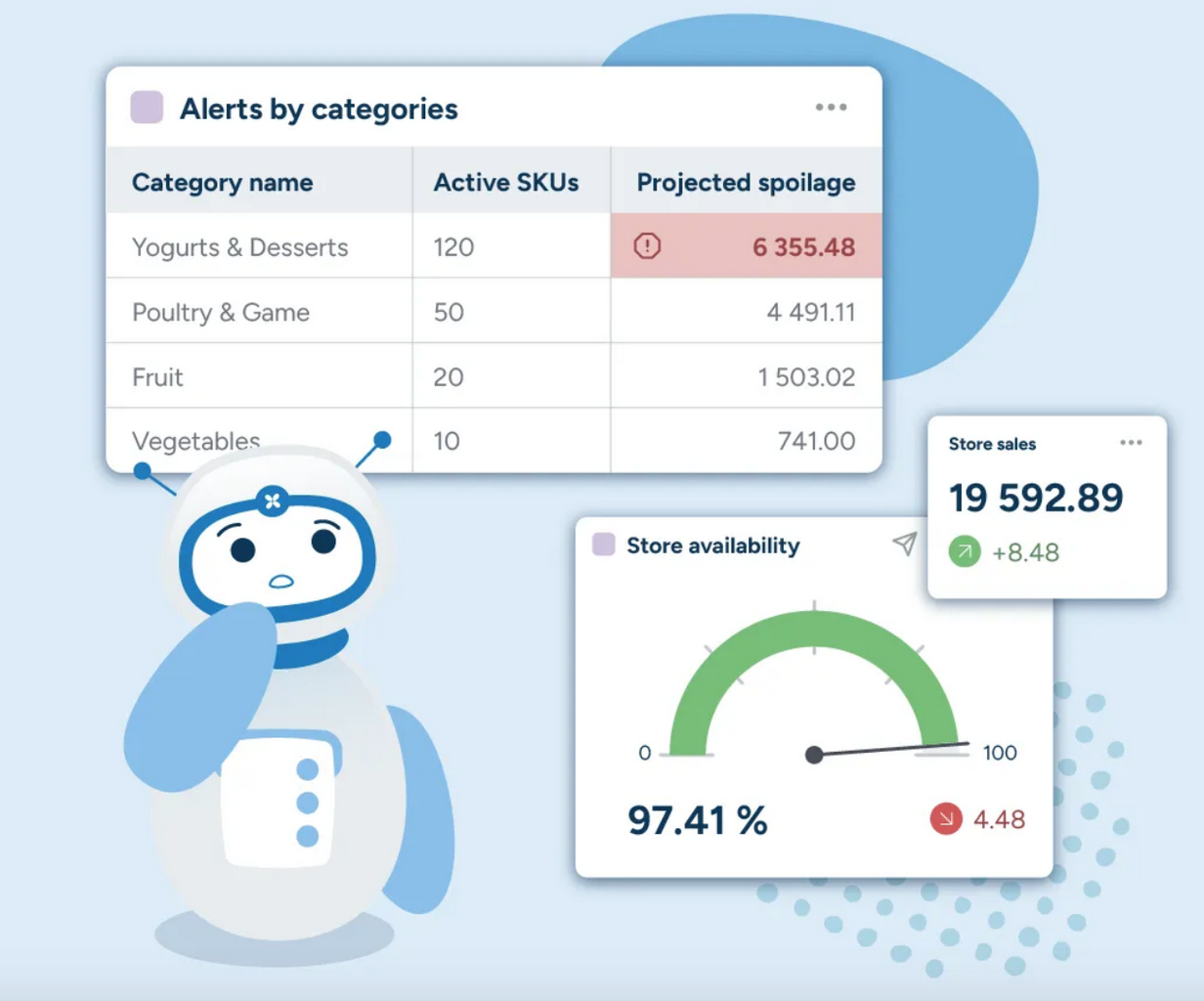
What it is: RELEX Solutions is an AI-powered retail and supply chain planning platform. They work with retail, wholesale and distribution, and CPG manufacturing — perfect for mid-sized grocery retailers, or retailers with seasonal planning.
How it helps reduce stockouts: RELEX reduces stockouts via automatically generating orders when needed thanks to cross-functional planning and the RELEX Mobile forecasting tool.
Key AI-Powered Features
- Automatic replenishment. Uses real-time data to automatically generate orders for a certain store or warehouse.
- Supply chain visibility. A wide-lens view of demand, supply, and store operations.
- Phantom inventory alerts. Uses predictive inventory to detect inconsistencies between recorded and actual inventory to reduce stockouts, excess inventory, and increased spoilage.
What Else to Know
Implementation with RELEX can be time-consuming. Once you’re up and running, though, RELEX scales efficiently in complex retail environments.
Pros and Cons
Pros:
- Works well across multiple systems
- Automatic replenishment
- Easily handles large inventories
- Scales up right along with you
Cons:
- Time-consuming to implement
- Likely out of budget for smaller teams
4. ToolsGroup: Stay Ahead of Demand with Self-Learning Forecasts
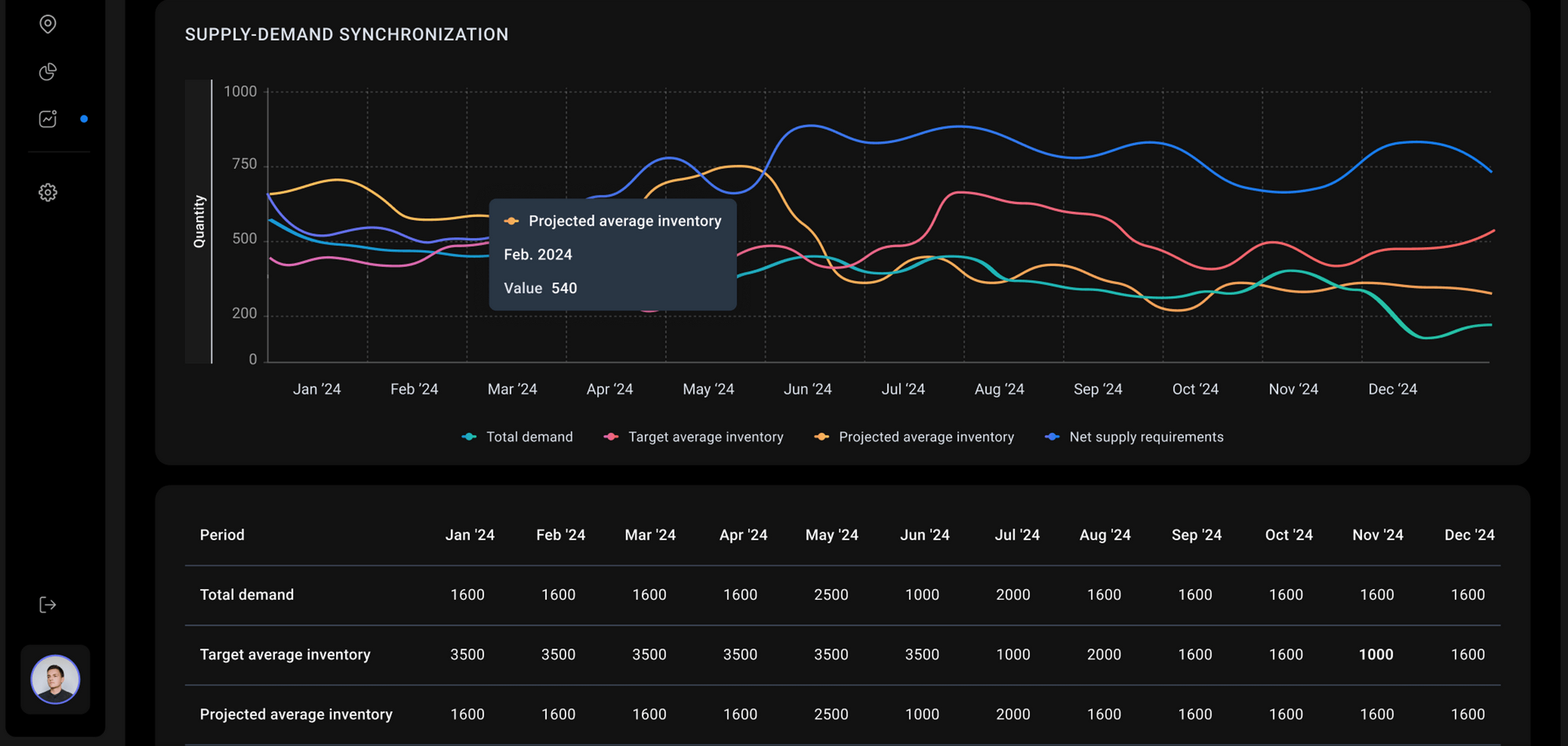
What it is: ToolsGroup, an AI-powered supply chain planning platform, helps with demand forecasting and inventory optimization across multiple locations. It’s best for mid-sized to enterprise-level retailers, distributors, or omnichannel businesses.
How it helps reduce stockouts: Probabilistic demand forecasting helps companies plan inventory more accurately even when conditions are unpredictable.
Key AI-Powered Features
- Probabilistic forecasting. Uses probability models to consider a range of demand outcomes so you can plan more accurately.
- Demand sensing. Looks at real-time data (weather, local events, sales metrics) and detects short-term demand shifts, allowing companies to take action before stock runs out.
- Scenario planning. Lets stakeholders model different supply/demand scenarios and map out the impact before making a decision.
What Else to Know
ToolsGroup has a powerful ERP integration, but the time and budget required for implementation is likely too much for smaller teams.
Pros and Cons
Pros:
- Easily handles complex supply chains
- Provides open visibility into AI decisions
- Flexible modeling adapts to inventory networks
- Self-learning forecasts adapt quickly to market shifts
- Good support for omnichannel inventory planning
Cons:
- Interface isn’t as intuitive
- Needs clean data for best results
- Overly complex for smaller teams
5. EazyStock: Automate Smart Reordering to Keep Essentials in Stock
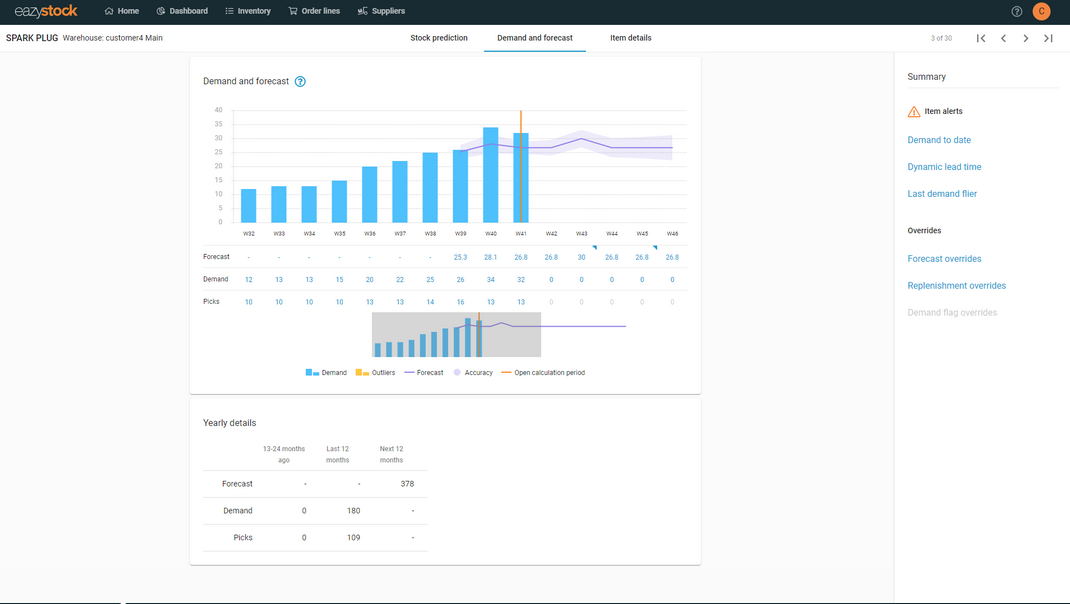
What it is: EazyStock’s cloud software automates manual processes to improve demand forecast accuracy and optimize inventory management. The ideal EazyStock customer is a small- to mid-sized distributor, wholesaler, or ecommerce business.
How it helps reduce stockouts: EazyStock prevents stockouts through features like AI-powered demand forecasts, automatic replenishment recommendations, and risk of stockout KPIs.
Key AI-Powered Features
- Forecasting and seasonal demand. Forecasts demand based on factors like seasonality, promotions, and product lifecycle.
- Redistribution suggestions. Reduces stockouts by monitoring inventory across locations and suggesting internal transfers to fill gaps in warehouses.
- Automated replenishment proposals. Generates order recommendations for your review and approval, cutting down on manual work and keeping everything in stock.
What Else to Know
If you’re an SMB in need of simple onboarding, EazyStock is likely a great fit for you.
Pros and Cons
Pros:
- Quick to implement
- Interface is easy to navigate
- Cloud-based with automatic updates
- High ROI for SMBs
- Automatic demand classification
- Good for businesses with multiple locations
Cons:
- Not designed for large enterprises
- Advanced customization is limited
- Focuses mostly on inventory, not full supply chain
Stay Ahead of Stockouts with the Right AI Tools
Choose the right AI inventory management software for your business by considering factors like the level of complexity you need and how well the tool’s integrations work. Adopting a solid AI software sooner rather than later ensures you’re ready to take on future trends in AI inventory management, such as generative AI for inventory strategy or prescriptive AI enabling faster decision-making.
With seamless, unlimited integrations and the perfect amount of features for mid-market retail brands, Tailor is among the best AI inventory management tools for mid-market retailers. Tailor’s advanced forecasting, flexible automation, and intelligent data validation help you meet demand and avoid costly stockouts — and because Tailor is built as a composable ERP, you can start with inventory and easily expand into purchasing, accounting, or fulfillment as your business grows.
Request a demo to see how Tailor can help you support your inventory strategy.
Quick Answers
What are the best AI inventory management tools?
The five top tools that help reduce stockouts: Tailor, Verusen, RELEX, ToolsGroup, and EazyStock. Each platform serves different business sizes and needs, ranging from small businesses to large enterprises.
How does AI help me reduce stockouts?
AI tools prevent stockouts by using demand forecasting, automated replenishment, and intelligent data validation. These features analyze your real-time data to predict demand shifts and automate reordering, ensuring you always have the right amount of stock available.
Which AI inventory tool is right for my business?
The best tool for you depends on your company's size and complexity. Use this guide to find your best fit:
| If you are a...
|
You should consider...
|
Because...
|
| Mid-market retailer scaling up
|
Tailor
|
It offers a flexible, headless architecture and AI-driven data validation perfect for multi-channel sales.
|
| Large enterprise (manufacturing/industrial)
|
Verusen
|
It specializes in cleaning complex data and optimizing MRO inventory for large-scale operations.
|
| Mid-sized grocery or seasonal retailer
|
RELEX
|
It excels in automatic replenishment and handling large inventories across multiple systems.
|
| Mid-to-enterprise omnichannel business
|
ToolsGroup
|
It uses probabilistic forecasting to handle complex supply chains and demand shifts.
|
| Small-to-mid-sized distributor or SMB
|
EazyStock
|
It is quick to implement, easy to navigate, and offers a high ROI for smaller teams.
|
